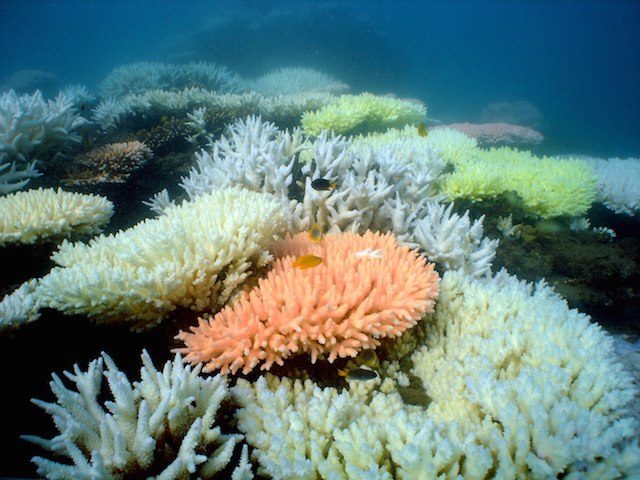SUMMARY
This is AI generated summarization, which may have errors. For context, always refer to the full article.

ILOILO, Philippines – The town of Concepcion is a third class coastal municipality in the province of Iloilo.
After being severely devastated by Super Typhoon Yolanda (Haiyan) in November 2013, one of the areas of concern for Concepcion was the effects of the typhoon on the town’s coral cover.
From 2012 to 2014, there was a decrease in the live hard coral (LHC) cover, although the reduction was not severe given that the area was previously hit by super typhoon Yolanda.
Some sites, however, like TakLut and Takpal were severely affected with a reduction of 59% and 52%, respectively.
Corals in these areas were mostly branching as evidenced by the increase in coral rubble cover – from 0% in 2012 to 20% in 2014. The location of TakLut, which is unprotected, amplified the typhoon damage.
Other areas were not severely damaged because of submassive-massive coral life forms.
Interestingly, coral cover in ButGam increased from 49% in 2012 to 73% in 2014. Corals in this area are dominated by massive-branching Porites, which are generally considered resilient and wave-tolerant.
Together with its 16 small islands, Concepcion is located in the north easternmost part of the Island of Panay. The largest of the 16 islands is Pan de Azucar. It has a total land area of 9,702.04 hectares and its municipal waters measures 96,481.56 hectares.
Interventions
But the people of Concepcion did not let the super typhoon affect their spirit. They immediately acted and came up with interventions to rise up again. (READ: Post-Yolanda, NGOs make things happen in north Iloilo)
They were able to fabricate and deploy 410 concrete artificial reef (AR) modules and 20 coral nursery units (CNU). About 5,243 live coral fragments or Corals of Opportunity (COPs) were also planted on 184 of the AR units and 20 CNUs. (READ: Is coral transplantation the way to save PH corals?)
Drupella, snails with shells that are covered in small spikes or bumps, were manually collected or removed.
According to the Reef Resilience Program, these snails can be found living on corals in reefs throughout the Indo-Pacific. They are frequently found hiding in crevices during the daytime.
Drupella eat live coral tissue by stripping the tissue from the coral skeleton and leaving white feeding scars that can quickly become covered by algae. Feeding scars can have detrimental effects on coral growth.
More than 100 kilos of these snails that attack coral polyps were disposed.
There are 11 local volunteers who were trained on open water diving in preparation for the coral rehabilitation project.
The Local Government Unit (LGU) also trained community volunteers from 11 coastal and island barangays on mangrove rehabilitation, care, protection and maintenance while mangrove rehabilitation plans were formulated.
They also developed backyard and community mangrove nurseries in 4 barangays with a total of 200,000 mangrove seedlings raised.
Some 97,802 mangrove seedlings were planted with a survival rate of 80%. Breakwaters were also constructed to protect the newly planted mangrove seedlings. (READ: Mangroves are the PH’s best shield vs climate change)
Around 120 hectares in Mt. Apitong underwent upland restoration and rehabilitation with a survival rate of 96%. Some 279,177 coconut trees were also treated for brontispa infestation. Brontispa longissima is a leaf beetle that feeds on young leaves and damages seedlings and mature coconut palms.
Other interventions
The town’s other interventions include:
-
Deployment of fish aggregating (or aggregation) device (FAD), a man-made object used to attract ocean-going pelagic fish such as marlin, tuna and mahi-mahi (dolphin fish). They usually consist of buoys or floats tethered to the ocean floor with concrete blocks.
-
Training on seaweeds and green mussel culture.
-
Construction of Marine Protected Area (MPA) guard houses
-
Fish catch monitoring
-
Coastal clean-up and awareness raising
-
Establishment of additional MPAs
The comprehensive intervention in Concepcion observes the following mantra in order to make a relevant and efficient DRR-CCA intervention:
-
Reducing fishing mortality
-
Enhancing stock recovery
-
Sustainable fisheries use
-
Threat reduction on ecosystems
-
Organizing fisherfolk communities
-
Restoring resiliency and connectivity
-
EAFM development with equitability; and
-
Diversifying livelihood options.
Aside from these, the LGU also believes that resiliency can be restored through learning communities. – Rappler.com
Add a comment
How does this make you feel?
There are no comments yet. Add your comment to start the conversation.